Discover a delicious combination of Asian flavors and Italian influences with this miso pasta recipe. The bucatini pasta is dressed in a creamy and rich miso sauce, and the crispy side dishes of fried sesame and fried nori add a touch of texture and authentic flavor.
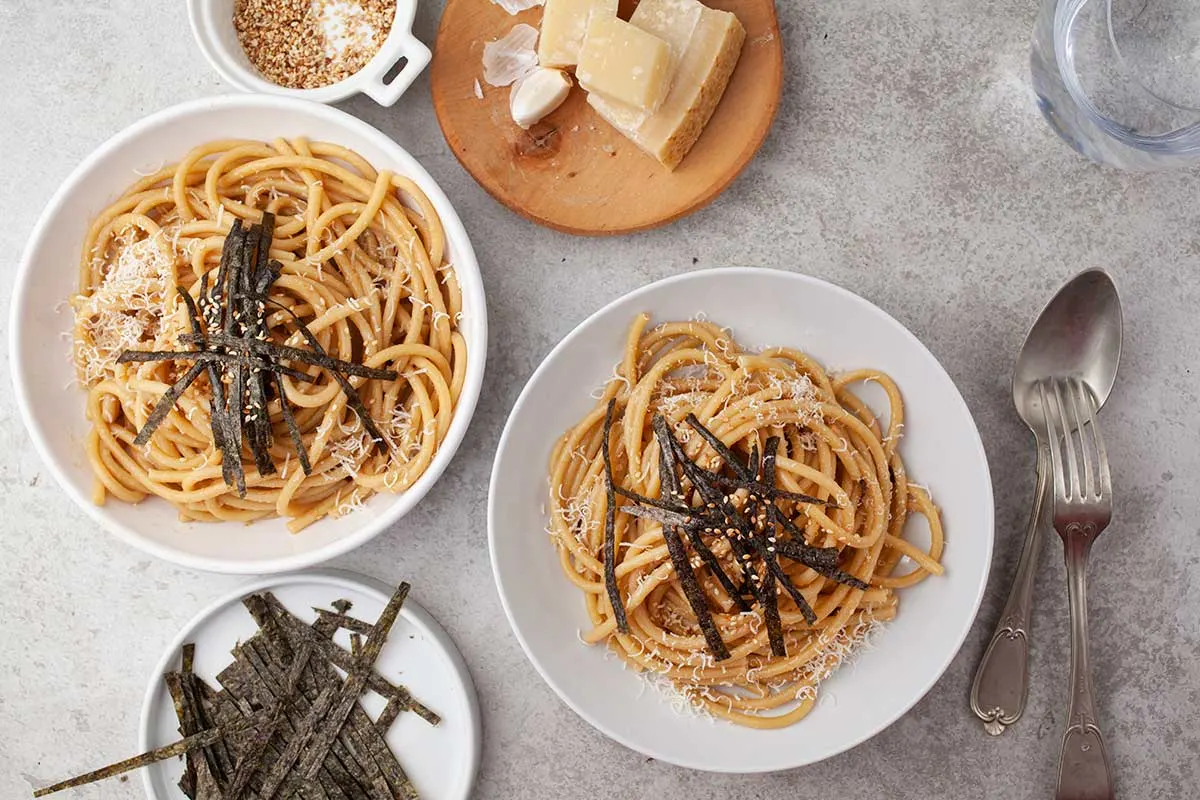
Miso paste has been a staple ingredient in my fridge ever since I discovered it a few years ago. It has an unmistakable taste and adds an Umami flavor to any kind of food you add it to. Inspired by its specific taste, I decided to use it for a pasta sauce as well, resulting in this delicious miso pasta recipe.
I used parmesan for this recipe, but it’s entirely optional, so this is basically a vegan miso pasta recipe if you just skip the cheese.
With this recipe you can enjoy both the Japanese culinary tradition and the Italian passion for pasta in one dish. Dare to try this refined recipe and surprise your taste buds with an explosion of mouth-watering flavors and textures.
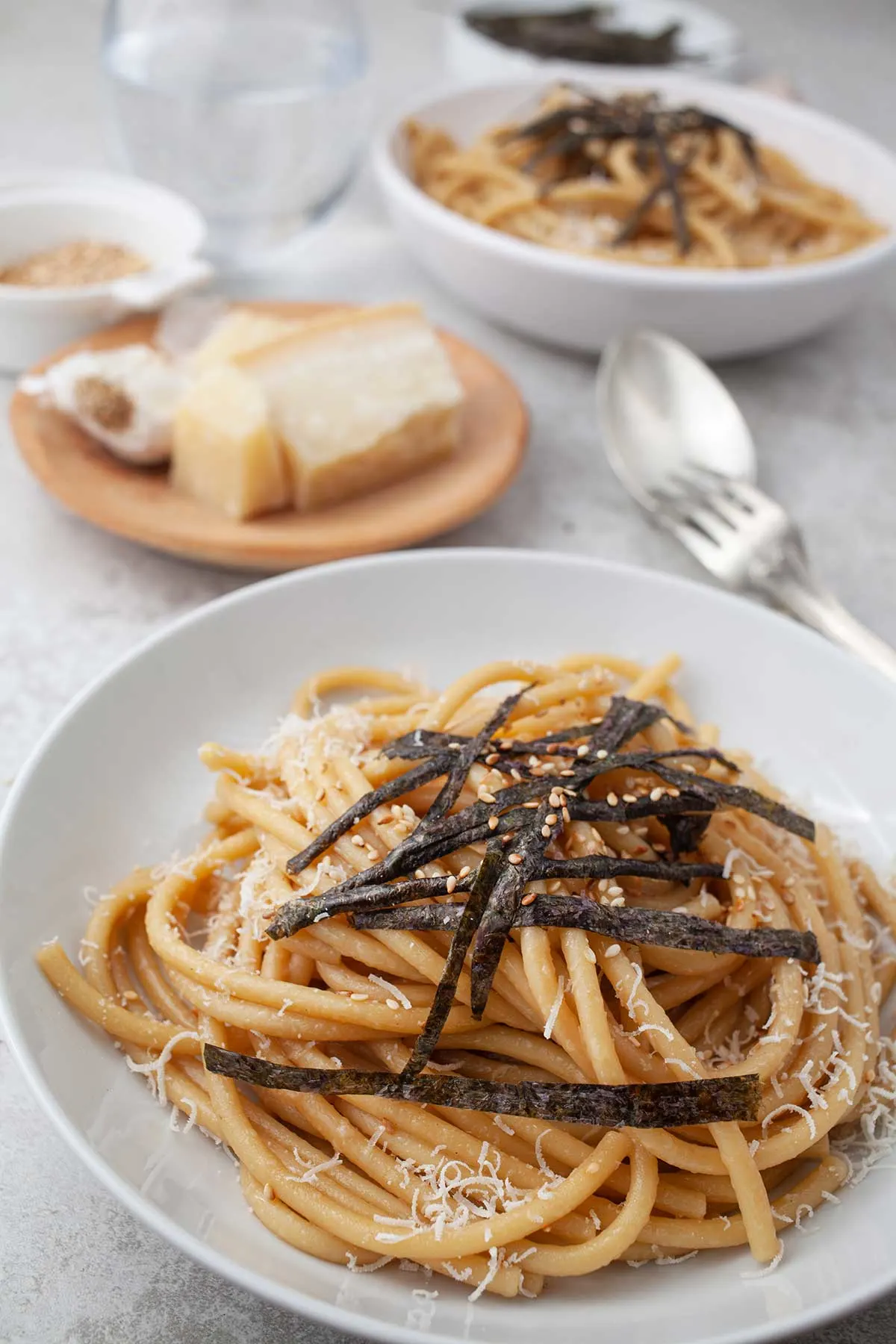
The benefits and uses of miso paste (fermented soybean paste)
Today I want to share some things about miso paste and tell you about its benefits and uses. If you haven’t tried it yet, you will discover that it is an incredibly versatile ingredient and full of nutrients!
What is miso paste made of?
Miso paste is a traditional Japanese ingredient with a long history. It is obtained by fermentation, traditionally made from fermented soybeans, along with a koji culture (Aspergillus oryzae), salt, and sometimes other ingredients like rice or barley. Fermentation gives the miso paste a complex taste, with salty and umami notes. There are several varieties of miso paste, from the most intense and strong to the mildest and sweetest, so you can choose what best suits your preferences.
Is miso actually healthy?
The nutritional benefits of miso paste are remarkable. It is a rich source of proteins, vitamins (such as vitamin K, vitamin E and vitamins from the B complex) and important minerals such as iron, calcium and magnesium. It also contains beneficial enzymes that support digestion and intestinal health.
The uses of miso paste are endless! It can be added to soups (see classic miso soup), sauces, marinades and even some desserts. You can also try using miso in salads, stir-fries or as a dip for vegetables. Experiment and discover how miso paste can bring a new and delicious dimension to your kitchen.
Is miso vegan or not?
Miso paste is vegan, however authentic miso soup usually contains katsuobushi dashi (fish soup stock), made using dried fish (bonito flakes).
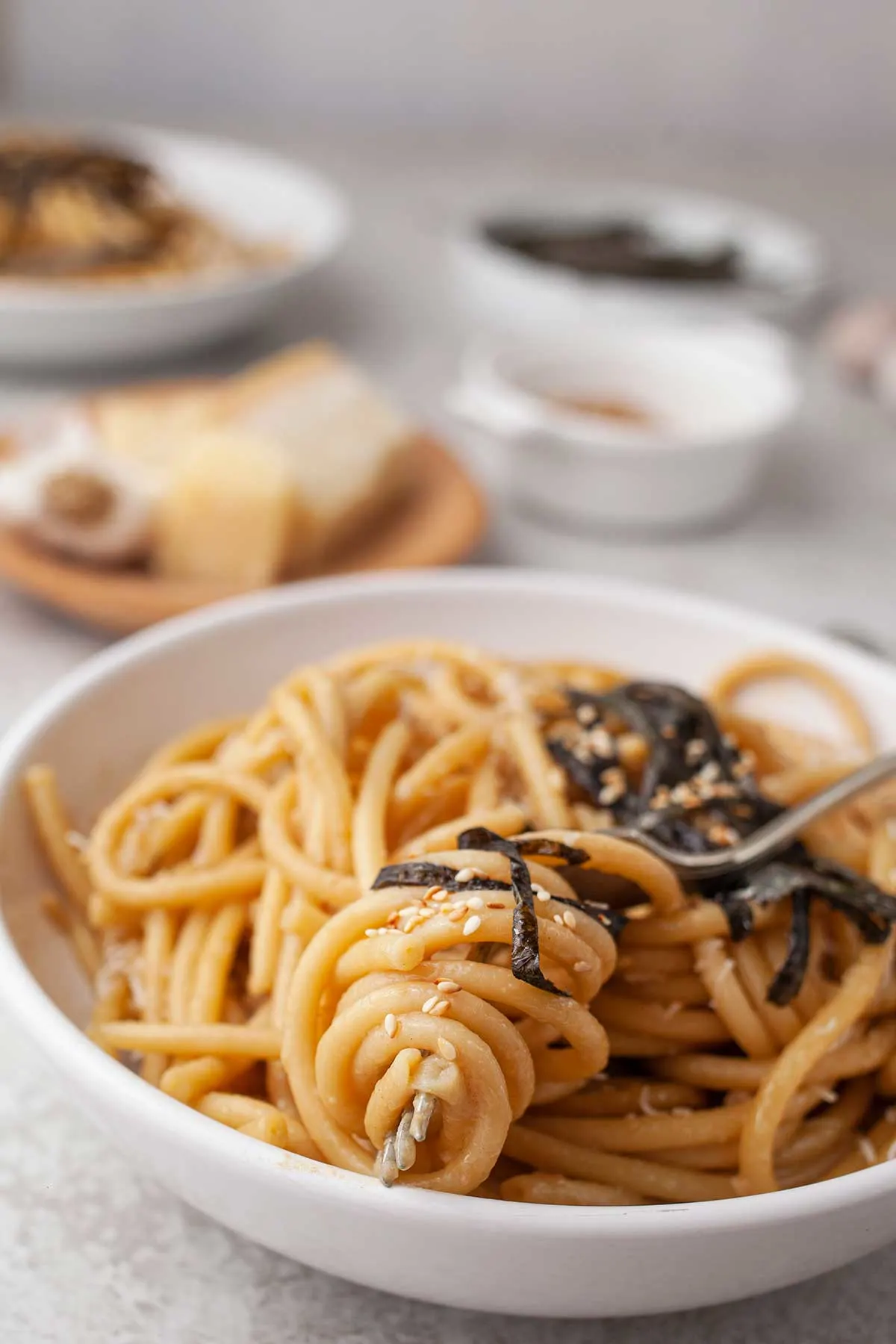
How to use traditional Japanese ingredients more often in your kitchen
Being a fan of Asian cuisine, traditional Japanese ingredients are among my favorites because they always bring a touch of magic and flavor to the kitchen. My favorites are fried sesame (goma), fried Nori and other edible seaweeds, as well as pickled ginger.
Let’s start with fried sesame, also known as goma. This wonderful ingredient adds a rich flavor and a crunchy texture. It can be used as a topping on various dishes, from salads and soups to noodles or rice. You can sprinkle fried sesame over cooked rice, fresh vegetable salad or even over ice cream for a delicious contrast between crunchy and creamy. Here is this short guide on how to prepare gomasio at home – a frequently used ingredient in the macrobiotic diet.
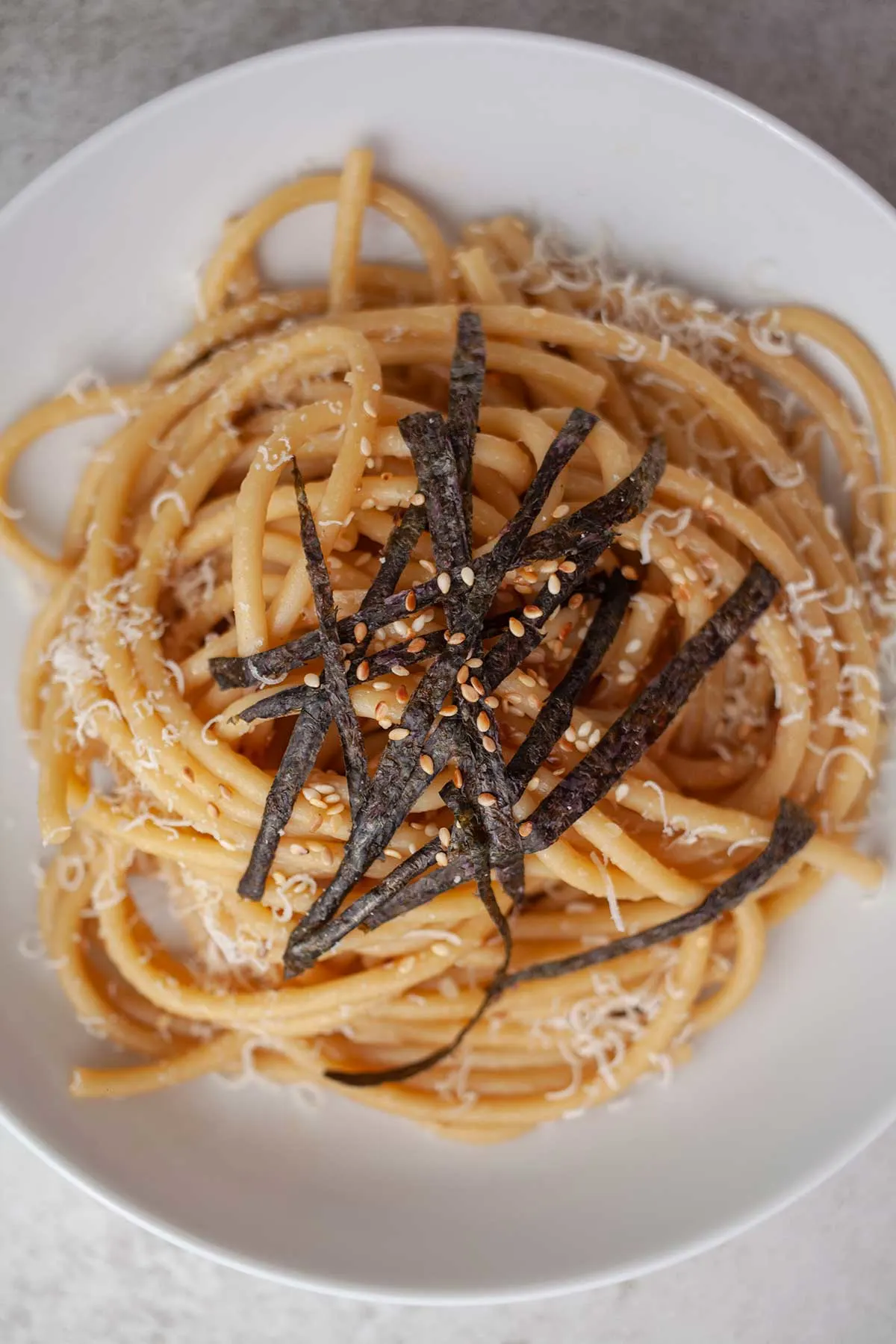
Fried nori, or nori algae, is another amazing ingredient that gives a distinctive touch to any dishes. These thin and crispy sheets of nori seaweed are often used to wrap sushi, but they can also be integrated into other types of food. You can break them into smaller pieces and sprinkle them over rice, add them to soups or mix them with fried sesame for a luscious topping. They can also be bought as a snack, flavored with chili, barbecue or garlic!
Pickled ginger is a versatile and tasty ingredient, perfect for bringing a hot and refreshing note to your dishes. You can use it in salads, sandwiches or burgers, add it to Asian dishes such as stir-fries, soups or curries, or even add it to drinks and cocktails for an exotic twist . Be sure to keep it in the refrigerator in a sealed container to maintain its freshness and enjoy the unique flavor that pickled ginger brings to your kitchen!
So, let’s venture into the Japanese kitchen and bring that traditional charm to our dishes. Using such wonderful ingredients we will add an authentic and surprising touch to our favorite recipes. Try to customize your salads, pasta, rice or sushi dishes with these ingredients and you will discover a new level of culinary satisfaction.

Miso Pasta
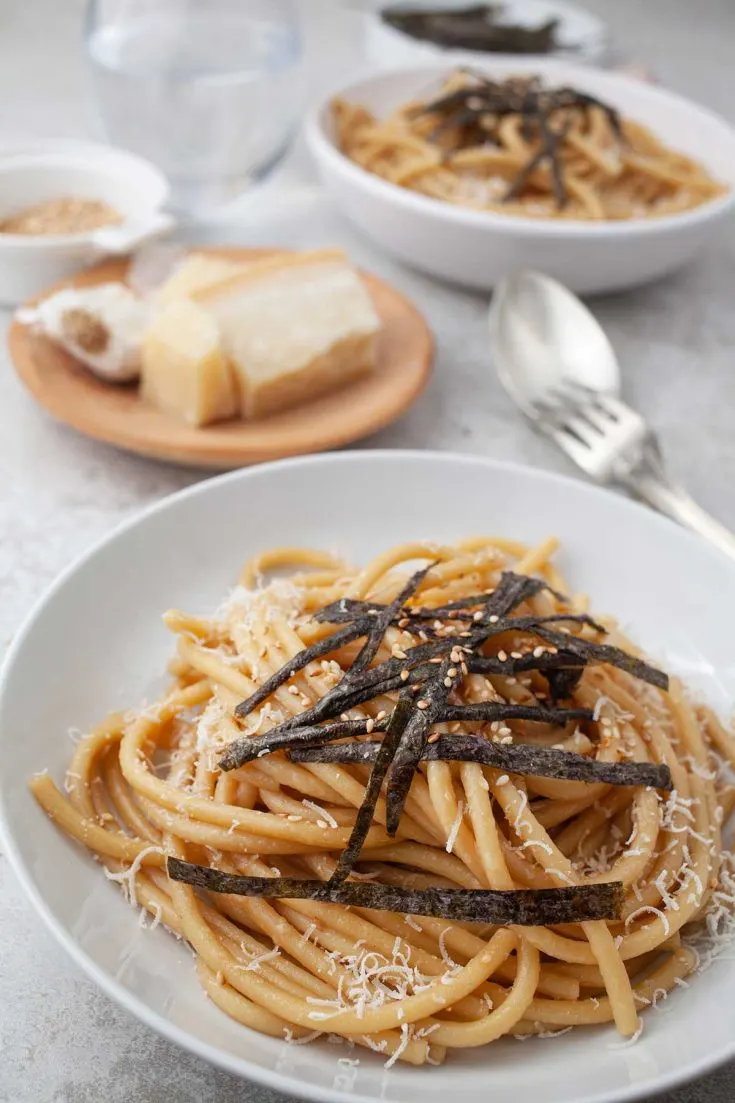
Discover a delicious combination of Asian flavors and Italian influences with this miso pasta recipe. The bucatini pasta is dressed in a creamy and rich miso sauce, and the crispy side dishes of fried sesame and fried nori add a touch of texture and authentic flavor.
Ingredients
- 180 g bucatini pasta
- 2 tablespoons butter (use vegan butter, for vegan version)
- 1 clove of garlic
- 2 tablespoons of miso paste
- 4 tablespoons sour cream (use vegan soy yogurt, for vegan version)
- 1 teaspoon nutritional yeast
- ½ teaspoon of salt
- ½ teaspoon pepper
- 1 tablespoon sesame, lightly toasted
- ½ Nori sheet, cut into thin slices
- 1 tablespoon parmesan, grated (use vegan parmesan, for vegan version)
- 1 tablespoon parmesan, grated (use vegan parmesan, for vegan version)
Instructions
- Cook the pasta according to the instructions on the package.
- Once al dente, transfer it to a bowl covered with a lid.
- Save the pasta water.
- In a pan, on medium heat, add the butter. When the butter is melted, add the garlic and fry it for a few seconds. Add the miso paste and ½ cup of pasta water.
- Mix well and add sour cream/yogurt and nutritional yeast. Mix until you get a homogeneous and creamy texture.
- Add the cooked pasta and continue to cook, mixing the pasta into the sauce, so that it absorbs as much of it as possible, for around 3 minutes.
- Serve the pasta warm, sprinkle with Nori strips and toasted sesame. Top with grated cheese.
Nutrition Information
Yield
2Serving Size
1Amount Per Serving Calories 441Total Fat 20gSaturated Fat 11gTrans Fat 1gUnsaturated Fat 6gCholesterol 49mgSodium 1323mgCarbohydrates 54gFiber 4gSugar 3gProtein 13g
I strive to keep the information as accurate as possible but make no warranties regarding its accuracy. I encourage you to make your own calculations using your preferred nutrition calculator.
